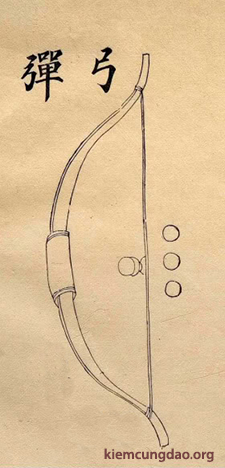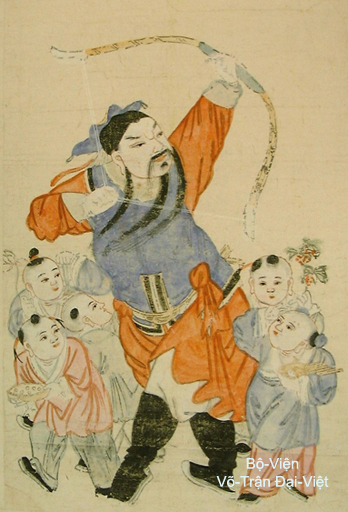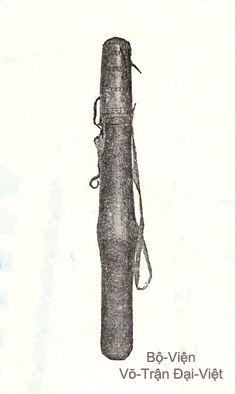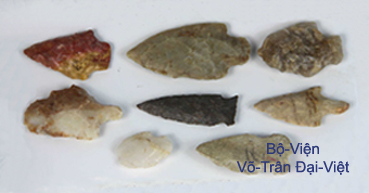II.
THE MEDIEVAL WEAPONS
1 - The Shooting Arms
A. Bow and Arrow
Cung-Tên
弓箭
There are two categories of Bow from Đại-Việt's Archery : the one used for hunting and the one used for war. The shape and the structure of Việt Bows are so inherent in his use as Hunting Bow or War Bow.
I - Shape of the Bow and his Structure :
Hunting Bow's category and the one of War Bow differ totally by the shape and the structure.
A - The Hunting Bow :
In Far-East, the Bow « Cung » (弓) used for Hunting is usually made of Mulberry tree wood - Morus alba, Morus rubra - (while in Europe, Bow is made of Yew wood, whis is also solid and soft in the same time). That's a Straight Bow of whom limbs are with "Simple Curved shape".
The Bow « Cung » (弓) was very early transformed in the history for giving two other versions of the Bow which were firstly the Crossbow & Ballista and secondly the the Pellet Bow « Ná » (梛), still called Đạn-Cung 彈弓, a kind of Bow with "Simple Curved shape", owning two strings tied to both ends and linked together in the middle to a piece of leather to be used for firing projectiles such as pebbles, stone balls or baked clay balls, lead marbles, glass marbles or steel marbles ; it was often used for hunting but also sometimes for war, but then with recurve Limbs being alike those of War Bow, and more flexible than the latter.
Hunting « Bow and Arrows ». |
Pelet Bow « Ná Cung 梛弓 ». |
« Pellet Bow » in usage at Saigon Archery Association, |
« Pellet Bow » in usage at Saigon Archery Association, |
In later times, the Pellet Bow « Ná » (梛) was transformed for inventing a kind of Crossbow « Nỏ » (in Hán-Việt Nỗ 弩), using for firing projectiles of baked clay marbles, glass marbles or steel marbles, called Pellet Crossbow « Nỏ Bắn Đạn » (Đạn-Nỗ 彈弩).
Pellet Bows for Hunting employing Marbles, |
Crossbow for Hunting employing Marbles, |
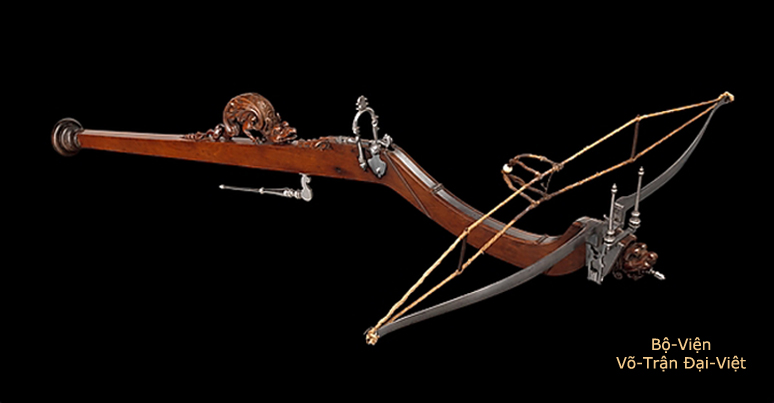
Crossbow for Hunting employing Marbles,
still called « Nỏ Bắn Đạn » (Đạn-Nỗ 彈弩)..
(France - circa 1550~1600 AD)
(Credit Photo : metmuseum.org)

War Pellet Bow « Đạn-Cung Trận 彈弓陣 ».
( Credit Photo : George Cameron Stone )
Celebrious Generalissimo Lý-Quảng (Li-Guang 李廣) |
Zhang-Xian using « Pellet Bow Đạn-Cung 彈弓 » |
Archer employing the Pellet Bow « Đạn-Cung 彈弓 ». |
The Marble Bow, also called « Đạn-Cung 彈弓 ». |
B - The War Bow :
Bow used for War owns limbs with "Double Curved shape" : there's Recurve Bow, built with composite material (Mulberry tree wood, Bamboo, Horn, Animal's Sinew, Leather).

War Bow
( Credit Photo : Stephen Selby )
In addition, the Bow employed for war in Đại-Việt kingdom owns also limbs made of steel. This kind of Bow was very in use under LÊ-Posterior Dynasty ; this is the category of Bows with Metal Frame « Thiết-Thai Cung », wearing the marks of influences from the « Kaman » Bow, inherent in the culture of India, still in use onto 19th century.
War Bow from Đại-Việt Kingdom |
War Bow from Đại-Việt Kingdom |
Kaman Bow from India - 19th Century. |
Kaman Bow from India - 19th Century. |
II - Bow's Made up Parts :
The Bow is formed by two essential elements : the Limbs of the Bow and the Central Body of The Bow.
A - Limbs of the Bow :
The Limbs of the Bow constitute the decisive part of the Bow's power and of Bow's quality. They are often made of homogeneous material for Hunting Bow, but always of composite material for War Bow and own both ends which the one is called the Bow's Prow «Cung Sao» (弓 稍) and the other, the Bow's Stern «Cung Nhị» (弓 弭).
B - Central Body of the Bow :
The Central Body of the Bow (the grip) enables to hold the Bow. it is made up of Bamboo and bovine's Horn and it requires a lot of attention.
|
|
III - Bow's Making :
According to the tradition, Mulberry tree wood is used for Limbs of the Bow, Bamboo and Buffalo's Horn are used for Central Body of the Bow (the grip).
Unstrung, the Bow is bended in such a way that the Bamboo is inside of the curve (Back of Bow), the horn outside (Belly of Bow). When the Bow is bended, positions are inverted (the Back is so the part which is towards the target).
The core of Bamboo is of only a piece, while the Buffalo's Horn is made up of two pieces putting on end to end. The Limbs of the Bow, made of Mulberry tree wood, sometimes reinforced of Horn or Ivory, are notched at the level of the Bow's prow and the Bow's stern for receiving the String.
The strip of Bamboo is pasted on both sides, which the one receive the Horn, and the whole is consolidated by a winding of Sinew. The Horn and the reinforcement of Sinew are pasted and covered with Dealbergia tonkinensis Bark, soft and resistant.
The Sinew, taken all along bovine's vertebral column, is of rectangulary section. When a bovine is killed, the Sinew is first dried in the sun, then soaked and softened in water and finally separated into fibers looking like flax.
The Paste (Phiêu-Giao - 鰾 膠 ) is drawn from fish's bowels and sturgeon's air bladder.
The Bow, which is just finished, is put to dry slowly in a room where a fire burns permanently. The time of drying varies between ten days to two months. The Bow perfectly dried, is polished, reinforced with the help of Paste and lacquered.
Owning to the softness of these material, the curved, light and short limbs store a lot of energy when the bow is bended. The form of the unstrung bow is similar to closed C shape. The end of limbs is est rigid on 20 cm and to serve as a lever (Called "Siyah" by Mongolians), inducing a reduction which permits to open the Bow. This reduction lever positions the Bow with "Double Curved shape" halfway between classical «Flat Bow» and modern « Compound Bow » with pulleys.
The War Bow of the Far-East is equiped with a « Stringrest Insert » on each rigid part of limbs - Bow's Prow «Cung Sao» (弓 稍) and Bow's Stern «Cung Nhị» (弓 弭) - supporting the string during his release at the shoot moment for increase the power of bended Bow's release, and that's what differentiate from the one of Near-East model.
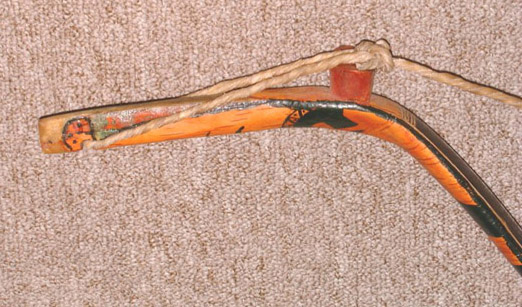
Far Eastern Bow Stringrest Insert
(Tibet)
( Photo Credit : Stephen Selby )
IV - The Arrow :
A) Arrow's Made up Parts :
1 - The Arrowhead : At the Prehistory, the Head of Arrow was made of Silex.Then later it was of Bone, then afterwards of Bronze, of Iron and finaly of tempered Steel.
Prehistorical Silex Arrow Points.
|
Medieval Steel Arrow Points.
|
Modern Tactical Arrow Points.
|
Modern Hunting Arrow Points.
|
2 - The Shaft : At the prehistorical time, the Shaft of Arrow was made of Wood ; consequently, because of his weight the Arrow was not be shot very far. At the Middle-Age, the Shaft of Arrow was made of Conyza, the Arrow could so be thrown more far. And it's precisely because of that, there's the expression «Tang-Bồng Hồ-Thỉ» (Bow of Mulberry tree wood, Arrow of Conyza) for talking about the ambition of a man.
However, the Shaft of Arrow made of Conyza was not solid to be used on battle fields, so the Shaft of Arrow was made later of Cedar wood, more solid and more soft in the same time.
Sometimes, the Shaft of Arrow was exceptionnelly of elephant defense's Ivory ; but there's the case of exceptional Arrows. For example : the Ivory Arrow of king Sở-Cung-Vương (Chu Gong Wang 楚 共 王) in the Warring States Period (475 - 221 B.C.) and which was given by the latter to famous expert marksman Dưỡng-Do-Cơ (Yang Youji 養 由 基).
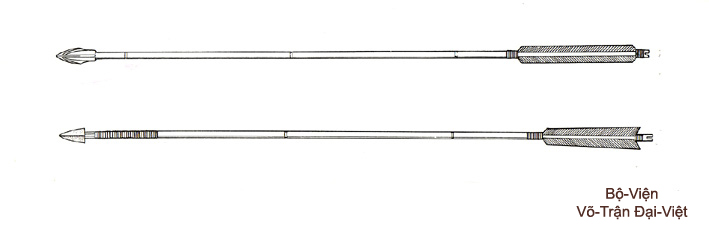
Medieval War Arrows
( Credit Photo : George Cameron Stone )
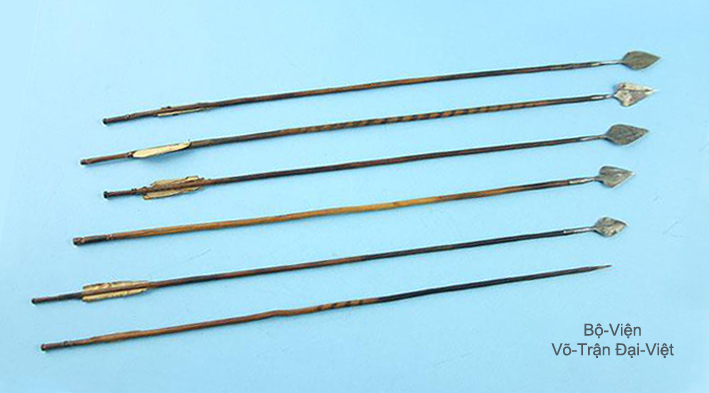
Far-East War Arrows
( Credit Photo : oriental-arm.com )
3 - The Arrowtail : It holds a Nock made of Horn for putting the string in order to release and it receives Flighting (or Fletching) made of Feathers so as to perfect Arrow's flight trajectory.
Modern Nocks made of Plastic.
|
Traditional Nocks made of Horn.
|
B) Arrow's Balance Formula of the Front of Center Percentage FOC % : In our days, science has found a Physical Formula helping to calculate the Weight of the Arrow Head from the Center of Gravity of the Arrow according to his length.
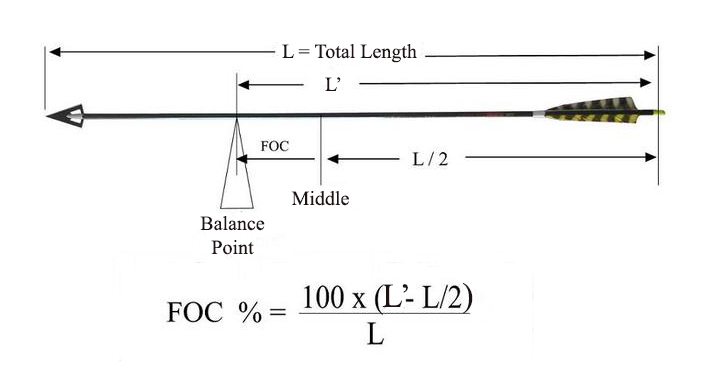
Calculation of FOC %
( Credit Photo : WebArchery )
If L is the total Length of the Arrow and L’ the length stretched from the extremity of the Tail untill the Center of Gravity of the Arrow, the Formula FOC % calculated for the Arrow Point in Field 100 grains (1 grain = 0,0648 g ) – i.e. 6,48 g – is therefore :
(L’ - ½L) 100
------------------
L
An Arrow's Balance of FOC % = de 10% à 15% is the better for Arrow's flight trajectory.
Nevertheless, the FOC % Formula above is only correct for the case of shooting on targets over a ditance more 50 steps (>36,50m) into more 100 steps (>73m) away.
While for the case of Equestrian Archery (Ky-Xạ - 騎 射) it's not applicable because there's shooting on targets which are for very short distance :
- In the Equestrian Archery of Hungarians, Chineses, Tibetians, Mongolians, Vietnameses or Koreans, the shooting is completed equally for a distance about 7m / 9m in Lateral Shooting into 35m in Front Shooting and Backward Shooting away ;
- And the one of Japanese Yabusame (流 鏑 馬 - Lưu Đích Mã) is made only in a range about 2,50 m into 3,50 m away).
C) Calculation Technique of Spine from Arrow Shaft :
The firing in Archery depend on the degree of Rigidity and Flexibility of Arrow Shaft and on the Powerful of the Bow.
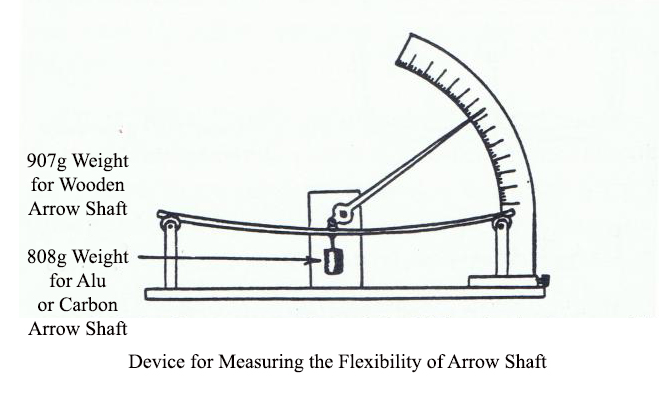
Calculation Technique of Deflection Determination from Arrow Shaft
( Credit Photo : Montjoie Grand-Sud Médiéval )
The more Arrow Shaft is bended forward the traction of the Weight the more Arrow Shaft is flexible and the more Bow employed for firing must be weak. Otherwise, the less Arrow Shaft is bended forward the traction of the Weight the more Arrow Shaft is rigid and the more Bow employed for firing must be powerfull.
The Mathematical Formula for determinating the degree of Rigidity and Flexibilty (called Spine) had been perfected by Kevin C. Kerlog as beloiw :
D = P (L)3 / K
where :
D = is the Deflection found in mm ;
P = the Mass of the weight (907g for Wooden Arrow Shaft ; 880g for Alu or Carbon Arrow Shaft) used for measuring the Deflection ;
L = the Length of Arrow Shaft used for the measure (in generic measure the Arrow Shaft makes 26" (660.4mm) for the one in Wood and 28" (711.2mm) for the one in Aluminium or in carbon ;
k = a Constant having to determinate beforehand according to the inverted formula K = P (L)3 / D where D is the Deflection in mm proper to the Arrow Shaft in use calculated for his generic length (26" ou 28" according to his nature either in Wood weither in Aluminium or in Carbon).
Committee of TRỊNH Quang Thắng. |
Bibliography
:
- “A Glossary of The Construction, Decoration and Use of Arms and Armor in All Countries and in All Times” by George Cameron Stone - Jack Brussel, Publisher (New York).
Return to Page MEDIEVAL ARCHERY
Copyright © 2004 - 2017 by ACFDV - All rights reserved.

